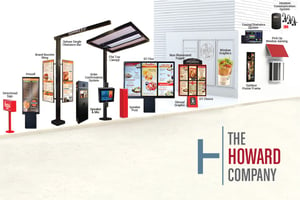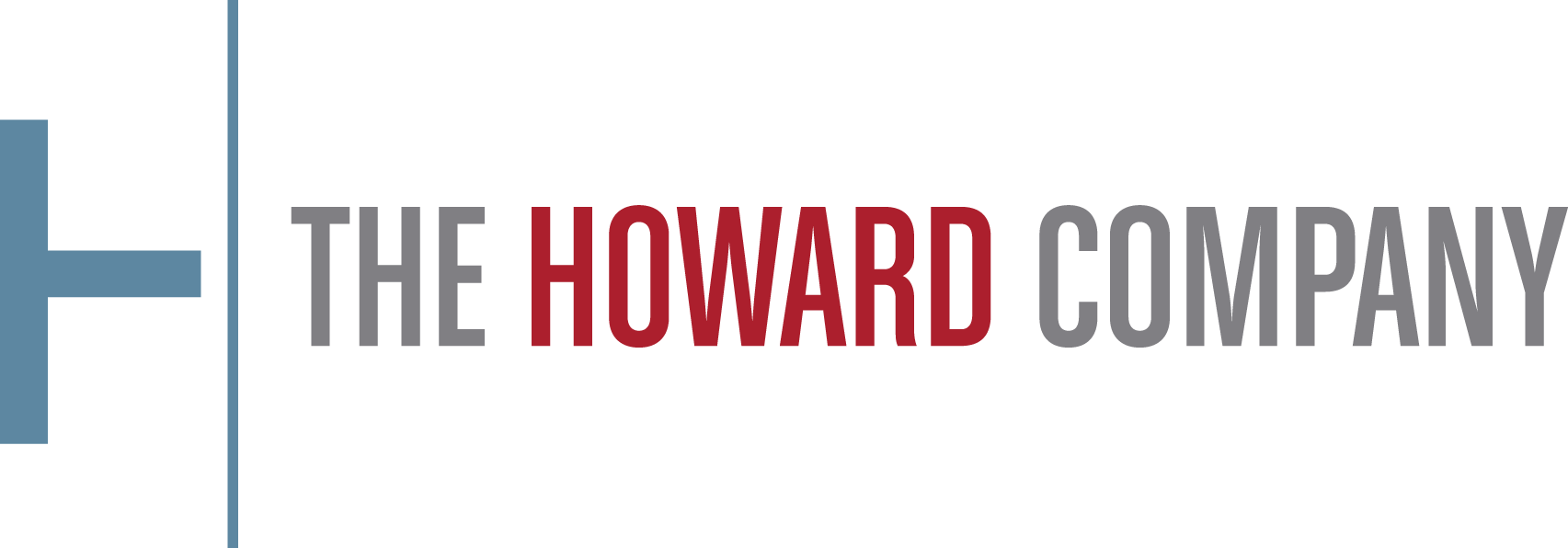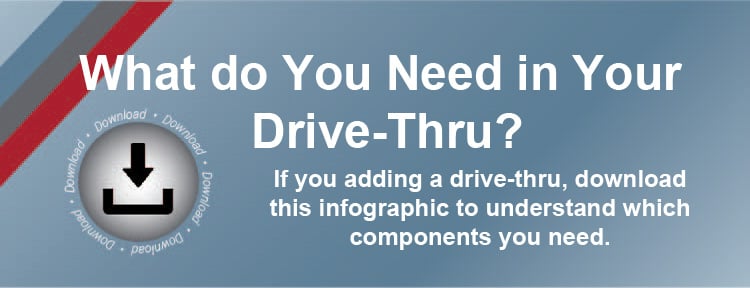
“To know what you know and what you do not know, that is true knowledge.” - Confucius
You have been approached by a potential customer who needs to build or refurbish a drive-thru. It makes sense to the client. You are well respected in your area. They don’t have the time to seek multiple vendors and piece the project together themselves, so they trust you to handle it. They are right in assuming that you are great at what you do and that you take the job. As you dig in, you realize that Warren Buffet was right when he said, “Risk comes from not knowing what you’re doing.” Speccing, building, and installing a drive-thru system is more than just installing a sign. Let The Howard Company help you get the job done and leave you with a very satisfied customer.
A Drive-thru is More than a Driveway with a Sign or Two
The average drive-thru user has no idea of what actually is all around them - they are focused on getting the coffee or burger. Designing a drive-thru takes quite a bit of thought. Take a look at “The Anatomy of a Drive-Thru”, which describes many of the components. Because each location is different - in concept, needs, budget, municipal codes, and many other factors, there are innumerable possible configurations of the drive-thru system.
Presell boards, directional signs, and menu boards seem similar to your other product offerings. However, do you have a supplier for the timing and communication systems? This is one of the most important technical elements and a key to the successful operation of this very important revenue stream. The magnetic loops installed in the order and pick-up areas are tied to the communication system. These components, especially the headsets, take a lot of abuse because of constant use. If they go down, the customer loses business and will look to you to fix the problem. Are you equipped to provide technical support for the communication systems?
Another essential ingredient for a profitable drive-thru is the menu board design. A menu board conveys a lot of information. It cannot be a simple list of available items. Poorly designed boards and absent pre-sell boards slow down the ordering process while guests struggle to find what they want. A minute delay for each car can have a significant impact on sales in the busiest dayparts. While poorly designed boards slow the process, they can also impact check averages. Menu engineering, tied closely to food cost and margins, is elemental. Well-designed menu boards draw the eye to those items that drive dollars to the bottom line. They also support the crew by doing some upselling for them. You certainly have excellent graphic designers on staff. Your team knows how to use colors and fonts and is trained to concentrate on the artistic quality of the design, but do they understand how to lay out a revenue-maximizing menu? Do they even know what questions to ask the customer?
The Drive-thru Signs are in Close Contact with Customers
There are many types of permanent outdoor signs but most have one thing in common - customers usually don’t come into close contact with them. Whether they are monument signs, channel letters, post signs, or any other kind, it is unlikely that customers will spend much more than a few seconds looking at them, and then usually from some distance. Slight flaws in the paint or other irregularities are not inconceivable.
Sign companies make excellent products, but perfection is not required for signs that are high above the heads or half a football field away from customers' eyes. In a drive-thru lane, the signs are less than 10 feet away, and customers may have plenty of time waiting to notice every blemish. Chipped paint, rust, imperfect seams, panels that don’t quite fit together - all of these flaws send subtle signals to the customer who is patiently waiting to order their soy latte. As noted above, the drive-thru equipment is more than a simple list of menu offerings. It is a branding tool as well. First impressions are important and if guests get the impression of laxity or indifference to detail because of flawed drive-thru equipment, they may very well assume the same about the food.
Drive-thru Equipment is Handled Frequently
Another difference between the typical outdoor sign and a drive-thru system is that the former is rarely touched after installation while the latter will be touched regularly. Doors and door locks on the drive-thru menu boards have to line up perfectly on the first use and many times thereafter. Remember, customers are able to see every imperfection.
If the client is using static menu boards in the drive-thru, the construction has to be highly engineered to withstand rough handling by employees who are charged with swapping out prices, entire menus, or Limited Time Offer (LTO) graphics from any of the components, from the presell boards to the main board to the side wings and toppers. A lot of moving parts that must fit seamlessly. Even small cracks can be quite visible at night on illuminated boards.
If the client is using digital menu boards, the above is still applicable. Although employees won’t have to swap out physical menus, the systems have to be highly engineered to protect the valuable digital screens they contain. If the system includes a topper or side wings for LTO’s, they will be opened frequently.
Because of the frequent opening and closing of doors, sometimes in harsh weather, replacement parts will be needed sooner or later. Custom-built systems need custom parts, and they can be very expensive. As noted above, most outdoor signage is built to set and forget, but not so with drive-thru menu boards. Regular maintenance and support also should be considered. Who will change out the menus or update pricing? What happens if the door doesn’t shut right? What happens if the drive-thru speaker post isn’t working? If any of the components need repair, the customer will call you expecting you to resolve the problem.
Drive-thru Systems Must be Changeable and Scalable
After a drive-thru system is installed, the customer may need or want to add to the installation. They might find a need for relatively inexpensive upgrades like directional signs or presell boards. But what if they want to add a side wing or a topper? The original custom sign you built for them probably wasn’t designed for add-on pieces. Keeping in mind that a polished appearance is very important, adding these components to a custom-built sign a year or two after the initial installation will not be easy or cheap.
If, after a couple of years, the revenue is so great, the client might decide he wants another lane. Now you need to rebuild the custom signs you did a few years ago, matching design and color. In addition, you have to work out the complicated timing and drive-thru communication system elements of the job. Plus, you will have to hire experts to lay out the traffic flow. The customer may want two lanes, but how will they fit in the space they have?
Another consideration is the future growth of the business. Many owners have dreams of adding locations. As a sign company, you understand the power of building a brand experience. If a customer wants to expand to another location, much of their success lies in duplicating the guest experience. The location of the new smoothie shop might be different, but in order to position the company for continued growth, every detail is important. People sitting in their cars notice things - good and bad - the same way guests waiting in line inside do.
You Need a Partner Who is the Drive-Thru Expert
Drive-thru systems are popping up everywhere and in many different types of business. This could be a growth area for your company, but repeating what Warren Buffet said, “Risk comes from not knowing what you’re doing.” That is why you need a partner who does - one who has sold and installed thousands of drive-thru systems across the country. The Howard Company solves the problems that sign companies might face when speccing, quoting, building, and installing a drive-thru. The Howard Company is:
-
A partner that has highly engineered products that hold up under harsh conditions and frequent rough handling, all while under close scrutiny of customers.
-
A partner who can supply all of the ancillary components, such as headsets, clearance bars, magnetic loops, content management software for digital signs, and even pick-up window awnings.
-
A partner who will support what they build, including a robust warranty, available replacement parts and a nationwide network of maintenance contractors.
-
A partner who can help the customer grow with add-on components and the ability to replicate the installation in a new location.
The Howard Company is the partner you need.


